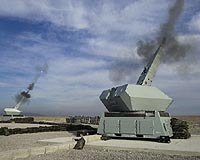| . |  |
. |
St. Louis MO (SPX) May 22, 2009 Boeing and Science Applications International have announced that the Future Combat Systems (FCS) program last week successfully completed its System of Systems Preliminary Design Review (SoS PDR). The SoS PDR is the most comprehensive review of the program to date. It validated that the designs for all FCS systems and subsystems, including the network, sensors, weapons and manned and unmanned vehicles, meet current requirements and will function as an integrated system of systems. The review proved that a family of networked systems will provide greater combat capabilities, including enhanced intelligence, surveillance, and reconnaissance capabilities, across the full spectrum of conflict. The review involved representatives from the U.S. Army, Boeing, SAIC, industry partners and other government agencies. It was conducted from May 11-14 at the Boeing facility in St. Louis. "This review marks a major milestone for the program," said Gregg Martin, Boeing vice president and FCS program manager. "It represents an end-to-end assessment that the program is meeting the Army's mission needs. This accomplishment was made possible by the hard work and dedication of the thousands of people who are part of the FCS team. We look forward to building on the substantial investments and progress made to date on the program in support of the Army's full spectrum modernization objectives." SAIC Senior Vice President and FCS Deputy Program Manager Dan Zanini noted: "Every system already has a functioning prototype undergoing test and evaluation, which greatly reduces risk for the balance of the program." The SoS PDR brought together the preliminary designs and architecture of the FCS brigade to assess them at an integrated level. In addition, the performance of the brigade design was compared with Army requirements. "Our combined team - Army, Boeing-SAIC and our industry partners - has done an incredible job preparing for and completing this milestone," said John Elbon, Boeing vice president and head of FCS Systems of Systems Integration. "It's amazing to see the capabilities the networked brigade brings to the warfighter." The SoS PDR is one of a number of major milestones scheduled for the program this year, which include a Defense Acquisition Board review and the Limited User Test of early FCS "Spin Out" capabilities later this summer. The FCS team remains committed to executing the program to the Army's plan and delivering these critical technologies to soldiers as soon as possible. This includes an acceleration and expansion of the FCS Spin Out effort to all Army Brigade Combat Teams over the next 15 years. Share This Article With Planet Earth
Related Links Science Applications International The latest in Military Technology for the 21st century at SpaceWar.com
 High-Tech Response To Rocket Attacks
High-Tech Response To Rocket AttacksDusseldorf, Germany (SPX) May 22, 2009 German troops serving in Afghanistan will soon be equipped with a highly effective new form of protection against rocket, artillery, and mortar attacks. The German government has contracted with the Dusseldorf-based Rheinmetall Group to supply the Bundeswehr with newly developed air defence systems worth around EUR110.8 million. The current contract encompasses two systems as well as an op ... read more |
|
| The content herein, unless otherwise known to be public domain, are Copyright 1995-2009 - SpaceDaily. AFP and UPI Wire Stories are copyright Agence France-Presse and United Press International. ESA Portal Reports are copyright European Space Agency. All NASA sourced material is public domain. Additional copyrights may apply in whole or part to other bona fide parties. Advertising does not imply endorsement,agreement or approval of any opinions, statements or information provided by SpaceDaily on any Web page published or hosted by SpaceDaily. Privacy Statement |